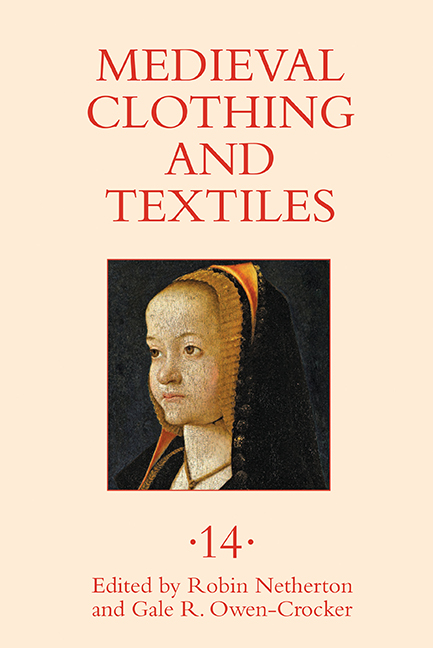Book contents
- Frontmatter
- Contents
- Illustrations page
- Tables
- Contributors
- Preface
- 1 Multicultural Clothing in Sixth-Century Ravenna
- 2 Byzantine and Oriental Silks in Denmark, 800–1200
- 3 The Bliaut: An Examination of the Evidence in French Literary Sources
- 4 Eyebrows, Hairlines, and “Hairs Less in Sight”: Female Depilation in Late Medieval Europe
- 5 Lexical Exchange with Italian in the Textile and Wool Trades in the Thirteenth to Fifteenth Centuries
- 6 Hidden in Plain Black: The Secrets of the French Hood
- Recent Books of Interest
- Contents of Previous Volumes
5 - Lexical Exchange with Italian in the Textile and Wool Trades in the Thirteenth to Fifteenth Centuries
Published online by Cambridge University Press: 13 July 2019
- Frontmatter
- Contents
- Illustrations page
- Tables
- Contributors
- Preface
- 1 Multicultural Clothing in Sixth-Century Ravenna
- 2 Byzantine and Oriental Silks in Denmark, 800–1200
- 3 The Bliaut: An Examination of the Evidence in French Literary Sources
- 4 Eyebrows, Hairlines, and “Hairs Less in Sight”: Female Depilation in Late Medieval Europe
- 5 Lexical Exchange with Italian in the Textile and Wool Trades in the Thirteenth to Fifteenth Centuries
- 6 Hidden in Plain Black: The Secrets of the French Hood
- Recent Books of Interest
- Contents of Previous Volumes
Summary
It is well known that Italians—especially the Tuscans and Venetians—played a pivotal role in the English textile and wool trades of the later Middle Ages. They dominated the luxury cloth market, importing silks and brocades from both their home cities and their extensive trading empires, and they were principal buyers and exporters of medieval England's most precious commodity: high-quality, raw wool. Records of this commercial activity have long attracted economic historians, with administrative documents from the busy port of Southampton—a key destination for Italian carracks and galleys—amongst the first to be edited, including the Anglo-Norman port books and the Middle English stewards’ books. More recently, Adrian Bell, Chris Brooks, and Paul R. Dryburgh have edited allowances and wool contracts drawn up between the Crown and Italian merchant societies in the late 1200s and 1300s, and Helen Bradley has published (in English translation) details of goods bought and sold by Italians in London, Southampton, and Hull in The Views of the Hosts of Alien Merchants, 1440–44. A key study by the cloth historian Lisa Monnas looked into the various silk types purchased by the royal household and reproduced sections of the Great Wardrobe inventories from 1325 to 1462. Similarly, a long-term project called The Lexis of Cloth and Clothing in Britain c. 700–1450 (LCC) has culminated in an online database of vocabulary from sources including the Anglo-Norman Dictionary (AND), Middle English Dictionary (MED), and Dictionary of Medieval Latin from British Sources (DMLBS), along with a related (yet separately funded) “multilingual sourcebook” of textile vocabulary in documents including wills, accounts, petitions, and rolls of livery. A large number of the sought-after, expensive fabrics in these records were imported from, and often woven in, Lucca, Florence, and Venice.
However, as the late David Trotter first highlighted in 2011, language contact between Italian dialects and Anglo-Norman (AN) is an area that has yet to be fully investigated, even though the first Italian loanword (AN fangot, “bundle of cloth” < It. fangotto) was identified over a century ago in a Southampton port book. Traditionally, loanword studies overlook insular French and assume a near-total dominance of Continental French (CF) as the conduit for Italianisms into England before 1500 and, indeed, direct borrowings from Italian into Middle English (ME) are very much a rarity in the corpora of the MED and the Oxford English Dictionary (OED).
- Type
- Chapter
- Information
- Medieval Clothing and TextilesVolume 14, pp. 113 - 140Publisher: Boydell & BrewerPrint publication year: 2018
- 2
- Cited by

